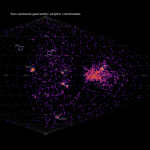By Alexandra Terentjeva and Ilya Kurenya
Abstract: This article describes the process of visual observations of meteor radiants according to the “Program-maximum” by Prof. I. S. Astapovich in Ashkhabad. 2021 marks 45 years since the day of his death.
1 Introduction
Among the many problems dealt with by I. S. Astapovich, we will only address one problem here – the visual study of meteor phenomena. He devoted most of his life to it and wrote hundreds of pages on it. During the Great Patriotic War, he was evacuated to Ashkhabad along with the Moscow University. In Ashkhabad the charm of the southern sky fascinated him so much that he stayed there for 17 years… He held observation every clear “moonless” night, while during the day he carried out extensive educational work at the Ashkhabad University, the Pedagogical Institute and others, preparing the Turkmen staff, as well as managing scientific work at the Ashkhabad Astrophysical Laboratory (AAL) that he had founded. In terms of the number of meteor observations he remained unsurpassed in the world taking into account such prominent meteor researchers as W. F. Denning, C. Hoffmeister and others.

Figure 1 – Igor Stanislavovich Astapovich (1908–1976) (from the personal archive of A.Terentjeva).
2 “Programme-maximum”
Observations were made according to “Programme-maximum” that he had created. This is a method of visually studying meteors as they evolve, seeking to make the most of the properties of the eye, taking into account its errors. In a split second the sophisticated eye of a specialist is able to spot not only the main features of the meteor, but most importantly their change over the course of evolution. This was the first time that attention was drawn to this within our country. “Programme-maximum” is set out in full on pages 89–112 (Astapovich, 1956).
But the enormous daytime workload and constant night-time observations could not help but take a toll on his health. When I. S. Astapovich decided to move from Ashkhabad, first to Odessa and then to Kiev, he was already very ill, although he continued to work.

Figure 2 – I. S. Astapovich on vacation during a river cruise along the Volga, 1969 (from the personal archive of A.Terentjeva).
I. S. Astapovich was a masterly observer, a romantic, sincerely devoted to the cause he loved. He wrote in vivid figurative language. We would like to convey to modern young people, who are keen on meteor observations, I. S. Astapovich’s description of the process of observation of meteor radiants itself, we would also like to preserve his style and imagery of language, as far as translation will allow. Therefore, we quote this description in full (Astapovich, 1956, pages 115–117):
“After 5-10 minutes of observation, the eye becomes accustomed to the darkness and an experienced observer sees the sky as if it were alive with meteors: some radiants set, others rise, the appearance of meteors in the shower changes with the change of the radiant height; some showers show themselves after 20-30 minutes, others only after several hours of work. After 40-60 minutes, one gets an idea of how the meteor sky is “breathing” today; sometimes that “breath” remains for 2-3 nights in succession, changing in the same way from evening hours to morning hours, sometimes the following night has nothing in common with the preceding one, and new radiants completely replace those of the night before. Usually, however, the life of a meteor sky is marked by a reasonably smooth replacement of showers by other showers, littered with the chaotic presence of sporadic meteors “without kith or kin”, or even sporadic radiants, those “caliphs for an hour” that appear once, sometimes in the brief splendor of a bunch of similar meteors, before disappearing forever. The reddish and orange slow meteors, prevalent in the early evening hours, are gradually ousted by the very swift white-blue meteors of the pre-morning showers, which constantly leave meteor trails. At first, as the radiant rises, the meteors are long and foggy: they pass at extreme altitudes, almost tangential to the Earth’s atmosphere, and can easily exit again into interplanetary space. As the radiants rise, their fall becomes steeper, they become shorter and sharper. Because of the perspective contraction near the radiant, meteors are very short and slow, and reach their greatest length and velocity at elongation ψ = 90° from the radiant. But as the zenith distance of the meteor increases it moves away from us, its path and velocity decrease, the increased distance and the influence of the atmosphere will weaken it and make it yellowish and it will “disappear without a trace”. By the end of the second hour, usually three to five of the main showers for a given part of the night have revealed themselves, but weak showers only hint at their existence with solitary meteors. We mentally find approximate “one-way” radiants from observations at one point, and the coincidence of these radiants is the first indication of the possibility of such a weak shower. When two hours have passed, over half of the suspected radiants have proved themselves in the meantime, and the rest either drift over the horizon, leaving the question open, or become silent, meaning they were either “caliphs”, or a chance meeting of two sporadic radiants, or –occasionally – an unfortunate observation error. But reliable radiants, the existence of which is beyond doubt, unceasingly continue “providing” more and more meteors, as if on purpose. Occasionally an alien would fall into their company: it also passes through a common radiant, like the other members of this shower, and could formally claim kinship with them. But it is poorly disguised: it is swift when the others are slow, or it is green-blue when they are reddish. Its physical and kinematic data “bring it out into the open” and qualify it as sporadic material. Any given night, 6 to 8 good radiants may be found in 4 to 6 hours, some were working yesterday, some will remain until tomorrow, but in the summer and autumn nights, the number of active radiants is 2-3 times greater, and the observer will “have a hard time” then. And it is only afterwards possible to track 30 to 40 radiants on a few exceptional nights, using long, multi-day processing. Once or twice a year, a poor third-rate radiant, no better than most, suddenly comes to life for no apparent reason; it starts at first a little, then more often, and a few hours later quite well emitting meteors singly, in pairs, triples, and even full streams, for several minutes. Such a radiant, having occupied the first place in the sky, sets majestically, giving a chance to see its sudden transformation elsewhere on Earth, or it starts to wane and in two hours only an entry in the observation log remains of its former splendour. It happens that in the midst of observations, when the timidly hiding radiants of weak showers are retrieved and every meteor is of great value, the sky gets covered by clouds or becomes pale, dawn comes or the Moon rises, or suddenly the sky is lit up by a fireball: if it is not fast, you can take binoculars and capture it in flight offhand; every time something interesting is seen. If it has left a trail, say farewell to weak radiants: it will keep for about 10-15 minutes until it completely fades and then you have to record it for at least half an hour and the description of the fireball should be as detailed as possible: you cannot see it often!”

Figure 3 – Sunset over the Volga (the photo by A.Terentjeva).

Figure 4 – Sunset over the Volga (the photo by A.Terentjeva).
The bibliography by I. S. Astapovich includes more than 800 works.
Extensive information on life and multifaceted scientific activities of Prof. I. S. Astapovich can be found in the works (Terentjeva, 2001), (Husárik et al., 2009), (Smirnov, 1999).
Acknowledgment
This paper was translated into English by I. Kurenya.
The authors thank Paul Roggemans for his efforts enabling the preparation and publication of this paper.
References
Astapovich I. S. (1956). “Опыт методики обработки визуальных наблюдений метеоров”. Contributions of the Institute of Physics and Geophysics of the Academy of Sciences of Turkmen SSR, 2, 5–121. (In Russian)
Husárik M., Pittich E. M., Solovaya N. A. and Svoreň J. (2009). “Asteroid 2408 upon the 100th birthday of Igor Stanislavovich Astapovich”. Contrib. Astron. Obs. Skalnaté Pleso, 39, 78–84.
Smirnov V. (1999). “Igor Stanislavovich Astapovich (1908-1976), Investigator of Meteoric Phenomena”. WGN, Journal of the International Meteor Organization, 27, 103–110.
Terentjeva A. K. (2001). “Igor Stanislavovich Astapovich (on the occasion of his 90th birthday)”. Astronomical and Astrophysical Transactions. OPA (Overseas Publishers Association), 20, 701–716.






As an American observer since 1966, I have to say that I am not familiar with Mr. Astapovich. But better late than never! Great article and wonderful sentiments throughout. Thank you!
Thank you very much for your kind comment, Mr Bias! I feel almost touched to tears by the fact that we managed to spark interest and spread word of the work undertaken by Prof. Astapovich.
A. Terentjeva